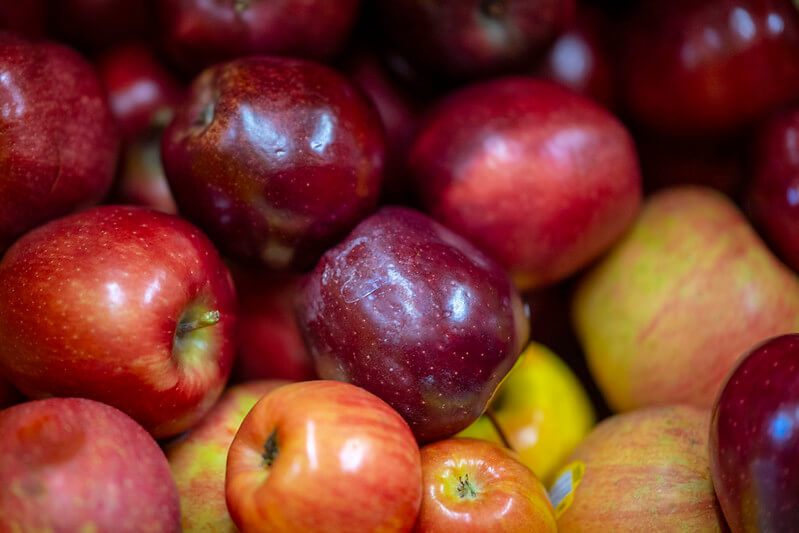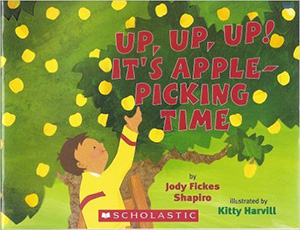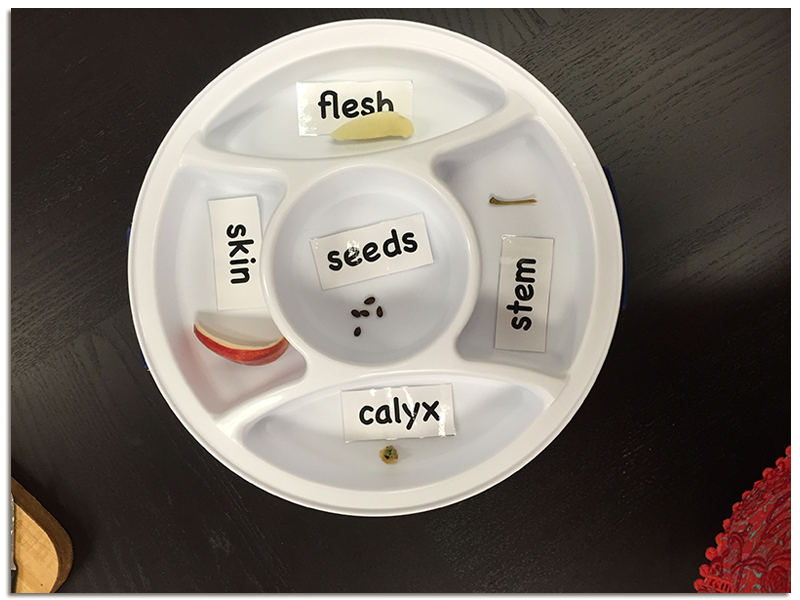A is for Apples
Students use their five senses to investigate apples, identify and model the parts of an apple, make applesauce, and discover how apples are grown.

Background
Lesson Activities
Recommended Companion Resources
Credits
Author
Lynn Wallin | Utah Agriculture in the Classroom
Sources
- http://www.usapple.org/index.php?option=com_content&view=article&id=179&Itemid=285
- http://www.nyapplecountry.com/about/fun-facts
Standards
Texas Content Area Standards
-
ELA: K.110.2.b.1
Developing and sustaining foundational language skills: listening, speaking, discussion, and thinking - - oral language. The student develops oral language through listening, speaking, and discussion.
- ELA: K.1.C: The student is expected to share information and ideas by speaking audibly and clearly using the conventions of language.
-
ELA: K.110.2.b.3
Developing and sustaining foundational language skills: listening, speaking, reading, writing, and thinking -- vocabulary. The student uses newly acquired vocabulary expressively.
- ELA: K.3.C: The student is expected to identify and use words that name actions; directions; positions; sequences; categories such as colors, shapes, and textures; and locations.
-
ELA: K.110.2.b.5
Comprehension skills: listening, speaking, reading, writing, and thinking using multiple texts. The student uses metacognitive skills to both develop and deepen comprehension of increasingly complex texts.
- ELA: K.5.H: The student is expected to synthesize information to create new understanding with adult assistance.
-
ELA: K.110.2.b.11
Composition: listening, speaking, reading, writing, and thinking using multiple texts -- genres. The student uses genre characteristics and craft to compose multiple texts that are meaningful.
- ELA: K.11.B: The student is expected to dictate or compose informational texts.
-
ELA: 1.110.3.b.1
Developing and sustaining foundational language skills: listening, speaking, discussion, and thinking - - oral language. The student develops oral language through listening, speaking, and discussion.
- ELA: 1.1.C: The student is expected to share information and ideas about the topic under discussion, speaking clearly at an appropriate pace and using the conventions of language.
-
ELA: 1.110.3.b.2
Developing and sustaining foundational language skills: listening, speaking, reading, writing, and thinking - - beginning reading and writing. The student develops word structure knowledge through phonological awareness, print concepts, phonics, and morphology to communicate, decode, and spell.
- ELA: 1.2.F: The student is expected to develop handwriting by printing words, sentences, and answers legibly leaving appropriate spaces between words.
-
ELA: 1.110.3.b.6
Comprehension skills: listening, speaking, reading, writing, and thinking using multiple texts. The student uses metacognitive skills to both develop and deepen comprehension of increasingly complex texts.
- ELA: 1.6.H: The student is expected to synthesize information to create new understanding with adult assistance.
-
ELA: 1.110.3.b.12
Composition: listening, speaking, reading, writing, and thinking using multiple texts -- genres. The student uses genre characteristics and craft to compose multiple texts that are meaningful.
- ELA: 1.12.A: The student is expected to dictate or compose literary texts, including personal narratives and poetry.
-
ELA: 2.110.4.b.1
Developing and sustaining foundational language skills: listening, speaking, discussion, and thinking -- oral language. The student develops oral language through listening, speaking, and discussion.
- ELA: 2.1.C: The student is expected to share information and ideas that focus on the topic under discussion, speaking clearly at an appropriate pace and using the conventions of language.
-
ELA: 2.110.4.b.6
Comprehension skills: listening, speaking, reading, writing, and thinking using multiple texts. The student uses metacognitive skills to both develop and deepen comprehension of increasingly complex texts.
- ELA: 2.6.H: The student is expected to synthesize information to create new understanding.
-
ELA: 2.110.4.b.12
Composition: listening, speaking, reading, writing, and thinking using multiple texts -- genres. The student uses genre characteristics and craft to compose multiple texts that are meaningful.
- ELA: 2.12.A: The student is expected to compose literary texts, including personal narratives and poetry.
-
Math: K.111.2.b.8
Data analysis. The student applies mathematical process standards to collect and organize data to make it useful for interpreting information.
- Math: K.8.A: The student is expected to collect, sort, and organize data into two or three categories.
- Math: K.8.B: The student is expected to use data to create real-object and picture graphs
- Math: K.8.C: The student is expected to draw conclusions from real-object and picture graphs
-
Math: 1.111.3.b.8
Data analysis. The student applies mathematical process standards to organize data to make it useful for interpreting information and solving problems.
- Math: 1.8.B: The student is expected to use data to create picture and bar-type graphs.
- Math: 1.8.C: The student is expected to draw conclusions and generate and answer questions using information from picture and bar-type graphs.
-
Math: 2.111.4.b.10
Data analysis. The student applies mathematical process standards to organize data to make it useful for interpreting information and solving problems.
- Math: 2.10.B: The student is expected to organize a collection of data with up to four categories using pictographs and bar graphs with intervals of one or more.
 Read the book Up, Up, Up! It's Apple-Picking Time by Jody Fickes Shapiro. As you read, discuss the following questions with the students:
Read the book Up, Up, Up! It's Apple-Picking Time by Jody Fickes Shapiro. As you read, discuss the following questions with the students:

 Each student will choose adjectives from their 5 Senses Chart to create a poem about apples. For each sense, they will write a sentence about the apples they were able to see, smell, feel, hear, and taste. Using the “Apple Book” template, cut a front and back cover and five pages. Write each sentence on one page of the book. Secure the book using a hole punch and ribbon.
Each student will choose adjectives from their 5 Senses Chart to create a poem about apples. For each sense, they will write a sentence about the apples they were able to see, smell, feel, hear, and taste. Using the “Apple Book” template, cut a front and back cover and five pages. Write each sentence on one page of the book. Secure the book using a hole punch and ribbon. nutrients to the apple. Place the stem by the “stem” card.
nutrients to the apple. Place the stem by the “stem” card.